Join us on a walk around Hospital Hill in Wanchai, looking for signs of the air-raid tunnel network that was dug under this hill. The hill is currently the site of the Ruttonjee Hospital, but at the time of the second world war you’d have found the Royal Naval Hospital located here.
Some sections of the tunnels were repaired shortly after the war in the 1950’s, but it appears that other repairs were made even before the war had ended. The 1980’s survey noted that some of the concrete reinforcements have Japanese characters written on them, suggesting that the repairs were made during the occupation. It is the only network I’m aware of that was repaired by the Japanese, so why was this tunnel singled out? Was it near a particularly important site for the Japanese? Or did they make use of all the tunnels, and this was the only network whose condition was bad enough to need repairs?
The 1950’s work also included backfilling and sealing large sections of the tunnels. Other sections were removed more recently when the Ruttonjee hospital was built. So, what’s still visible today? I used to work in Wanchai, but hadn’t ever noticed any signs of the tunnel, so I didn’t have high hopes. I was pleasantly surprised though, and found many of the portals are still clear to see – if you know where to look.
For the first one, you don’t need to look at all – just follow your nose. Behind Wanchai Market on Queen’s Rd East you’ll see /smell this rubbish collection point.
On the back wall you can just see the concrete pillars that are on either side of the portal 61. They’re easier to see if you walk up the concrete staircase behind the market, and look down.
Then if you look down on the other side of the staircase, you’ll see portal 62.
Close up, it’s in relatively good condition. Although I didn’t notice it at the time, looking at the photo now you can clearly see the number ‘62’ painted on the right pillar. It’s the first time I’ve seen a portal with its number shown – but I should go back and have a look at the photos of other portals, as I wasn’t looking for the numbers before.
These pillars with their vertical grooves are often the first sign of a portal. This portal gives us a good idea of their use. Take a closer look at the top of the left pillar:
You can see the groove has a metal rail, and at the top is a pulley wheel. Moving round to the other side of the pillar we see:
There’s another groove, with a concrete block counterweight still in place. So it looks as though the portals had flat doors that would lift up vertically, with concrete counterweights connected via cables to help make it easier. Several of the portals on this walk have one or both counterweights still present.
There’s not much of a chance to look inside, as the iron door doesn’t have any vent or grill. You can just make out a small rust hole in the bottom of the door though. Luckily it was large enough to poke my little camera lens through. The view inside is much the same as the others we’ve seen.
Portals 63 and 64 are no longer in sight, as the hillside was excavated when this access road was built.
The road runs past the North end of the market building, from Wanchai Road up to the Ruttonjee Hospital. Although the portal 63 is gone, as you turn into the access road you can still see the curve of its tunnel roof showing through the sprayed concrete on the hillside.
Portal 64 would have been a little further along this road, but there’s no sign of the portal or its tunnel now.
Look on the left of the road though, and you’ll see these strange stone shapes, as spotted previously by Bush.
Can anyone identify them? To me they look like decorations for the top of some main gateposts?
A little way beyond the stone shapes, you can see a green roof covering the staircase down to Wanchai Road.
Although the roof is modern, the steps and arched doorway look to be much older. I hoped that since they were old, they marked the wartime line of the wall, meaning we’d have a good chance to see the other portals in this area.
Looking to the right though, you can see a white concrete retaining wall had been built fairly recently.
It covers the older stone wall, and so hides any sign of Portal 65.
Portal 66 emerged some way back from this wall line, and is buried under the access road we just walked along.
How about Portal 67, which should be to the left of the arched doorway? Here’s the view to the left…
Lots more fresh concrete, so it doesn’t look very hopeful. But look carefully just to the right of the grey aircon duct, and you can see a couple of familiar looking grooved pillars.
Walk along the alley, and there’s no doubt of the shape.
This portal is high off the ground, but the concrete staircase to reach it is still there. Unfortunately it seems to have been taken over by the local hardware shop as their storage area, so this is as close as I could get.
So we retrace our steps to the arched doorway, then walk out to Wanchai Road and turn right. Follow Wanchai Road around then when you reach Bullock Lane, turn right and walk towards Wanchai Park.
Just before the park is a small sitting out area on the right, and a narrow lane behind the buildings shown on the right edge of this photo.
Peer down the lane and you’ll see another pair of grooved pillars.
This set belongs to portal 68. It’s also set high in the wall, but this time there’s no sign of any staircase or ladder to reach the level of the tunnel.
Walk back towards the park, and as you reach the entrance you’ll be standing in front of this wall.
Portal 69 should have been in the centre of the picture – probably raised like the last two, No sign of it now though.
Finally, if you walk into the park and look up to your right, you’ll see this concrete block sticking out of the hillside.
This is the tunnel that led to portal 70, the last of the portals for this network.
As always, if you have any stories, information, or history to share about these tunnels and this part of Hong Kong, we’d love to hear from you.
MrB.
PS You can read more about the history of Hospital Hill in the earlier Mount Parish History article.
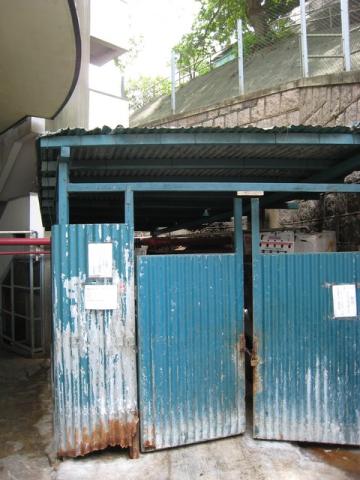

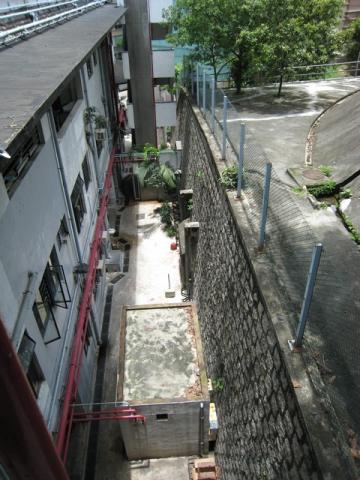
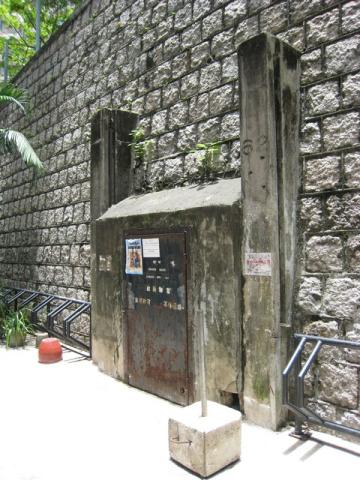
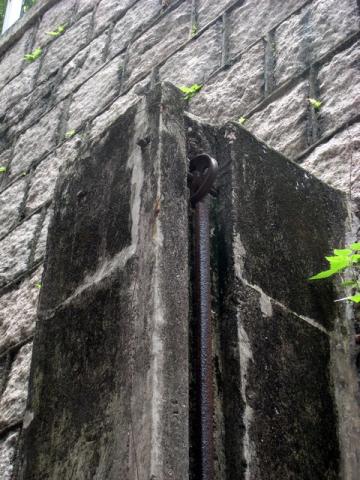
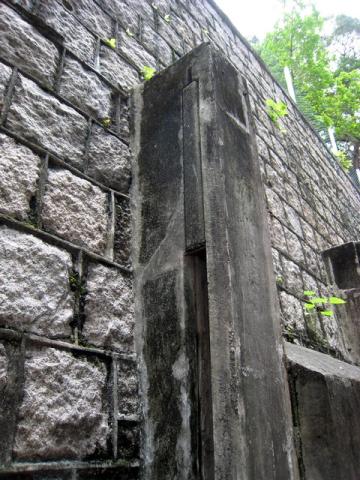
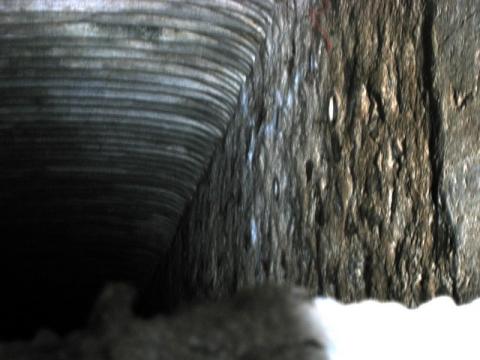
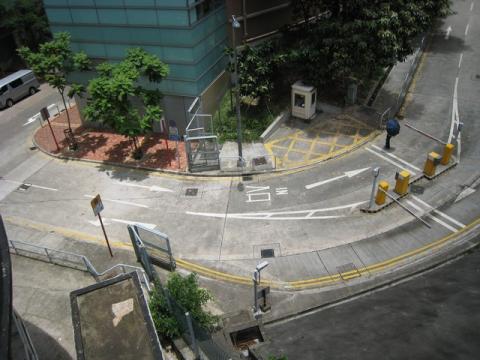
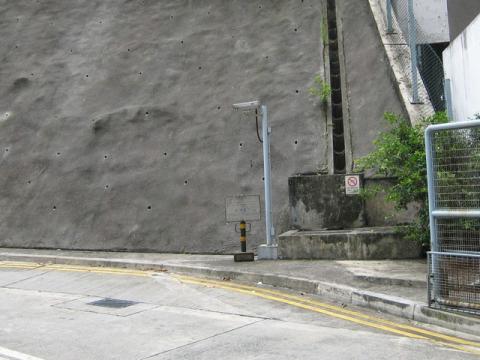
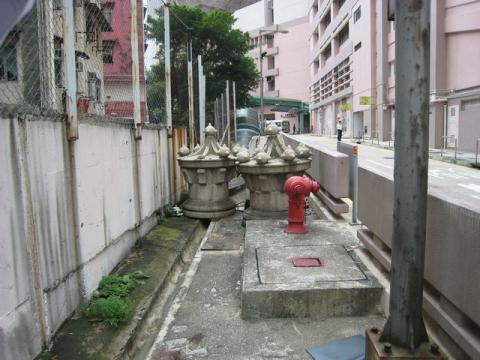
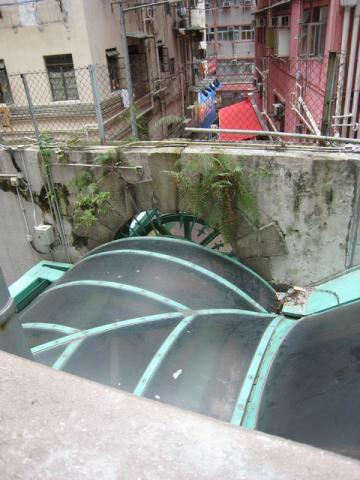
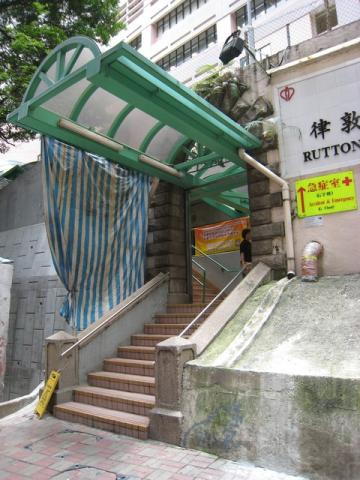
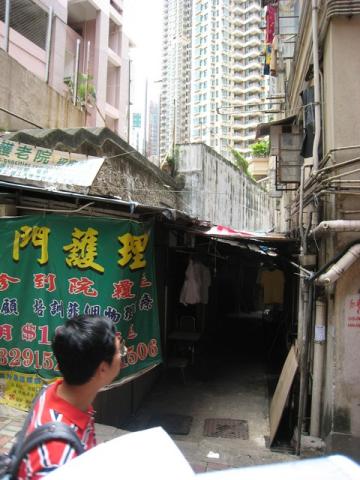
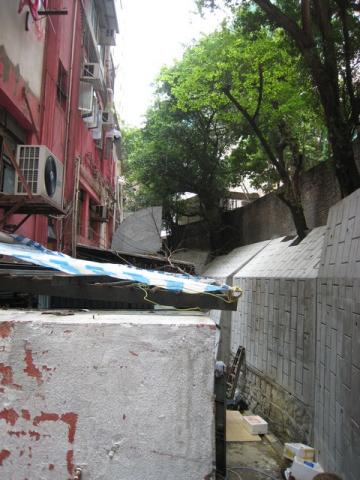
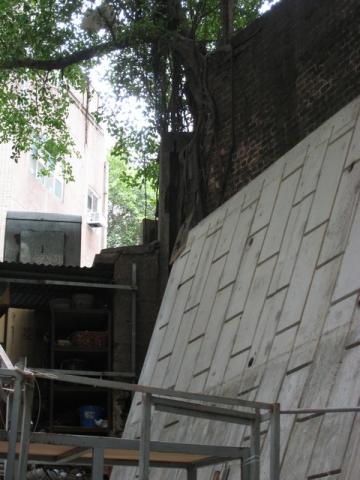
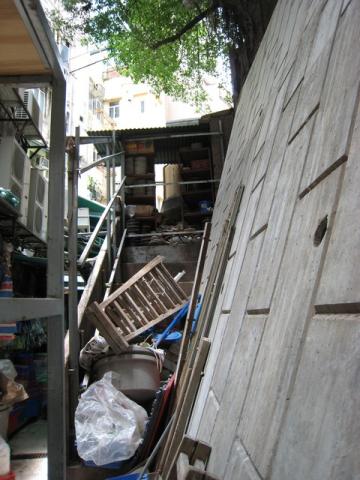

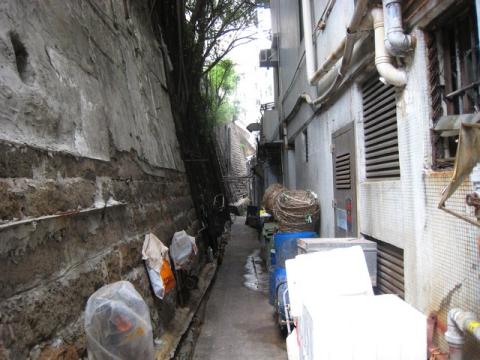
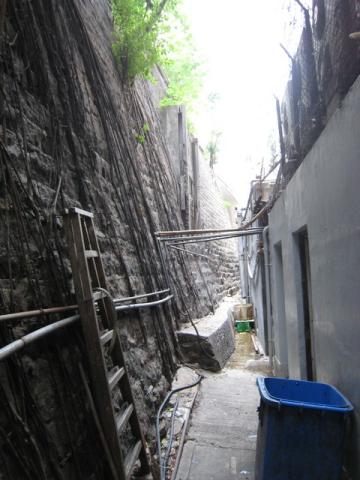
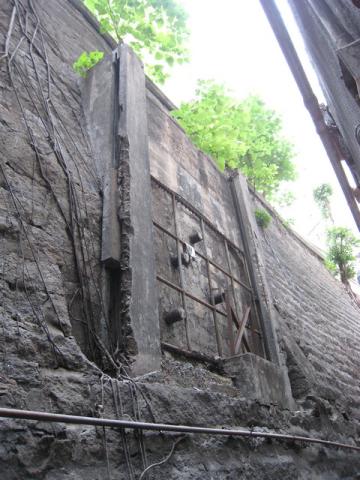
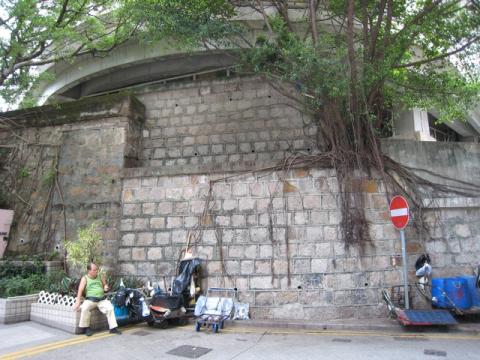
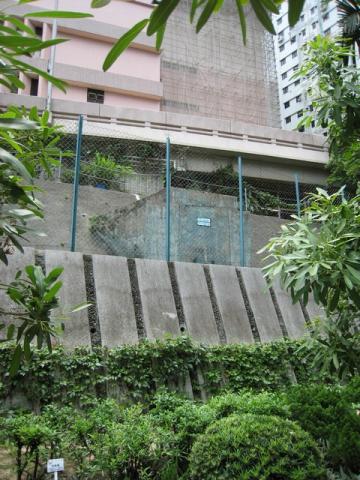
Comments
Portal 69 of ARP tunnel under hospital hill
As far as I known, the sitting out area just in front of the entrance of Wanchai Park was once the site of a building. The building was knocked down by a landslide in the 60s. (killing several people) The stone retaining wall blocking Portal 69 may be one of the slope stabilising measures after the landslide. Besides, during the construction of the current Ruttonjee Hospital, the contractor had overcut (i.e. digging deeper than enough) the slope just above Portal 70 and exposed the structure supporting the roof of the ARP tunnel. I was lucky enough to see the supporting structure before the contractor cover it up again.
Portal 70
Thanks for the extra information about the area. Did you realise what the structure behind portal 70 was when you saw it?
We used to live opposite the Westwood shopping mall in Shek Tong Tsui, and our flat overlooked the excavations into the hillside as they were building it. At one point we could see they'd dug into a tunnel, but at the time I had no idea what it was. A few years later when I started looking at the history of the ARP tunnels I realised it was the tunnel connecting the South Lane and Belcher's St networks.
Regards, MrB
Original gate at Portal 68?
One of our readers points out a local site that has a couple of Chinese-language posts based on Batgung articles, including this one. The author gets a black mark for not quoting us as their source, but then redeems himself with the interesting observation that the gate at portal 68 appears to be original:
At first that seemed unlikely - with the shortage of metal during and after the war years it seemed that surely the iron gate would have been taken away? But look at this photo taken in 1941:
We can see the gates are raised and have exactly the same shape and layout as the gate at portal 68. Against the odds, it seems another little piece of wartime history has survived.
MrB
Hello! I'm the author of
Hello! I'm the author of the local site that you pointed out. First of all, I should apologize for not having Batgung's site acknowledged in my site. With a bit of interest in the topic of ARP Tunnel, I was glad to have found Batgung's site. Amongst other portals that I knew in Shaukeiwan, Happy Valley and Kennedy Town, I followed the footprints of Batgung to some portals in Wanchai. All the photos showed at my site were not reproduced but truly taken by myself. Actually, my site was a "blog" and I just wrote it for self-entertaining. Anyany, to avoid misconception, I have deleted the articles on my site.
Back to the subject matter, I trust the gate in front of portal 68 was original because I noted it joined with the iron rail on the inner side of concrete poles in very good fit. However, I guess it should only be the frame of the original gate as there should be finer iron grids within the thick grids (just as the one I saw on an old photo depicted in a book).
Glad to have learnt from you!
No need to delete
Hi, thanks for writing.
If you can easily recover your posts, it would be great to see them back online again. Having a chinese-language version of the information can help attract other local people who are interested in the subject. Also I thought your photos were better than mine, especially the photo of the inside of the tunnel.
Please just add a link somewhere in your post so it links back to the related article here, so people reading your site can see what other information is available.
Was the old photo you mentioned the same one as the black & white photo shown above? If not, please could you let me know the name of the book it appeared in? I'm interested to see other pictures of the tunnels as they looked when they were new.
Thanks & regards, MrB
This book with a lot of old
This book with a lot of old rear HK photos. Including wartime and air raid tunnel. http://www.jointpublishing.com/model/bookdetail.asp?ISBN=9789620414725
Portal 111
Hi,
The deleted posts could hardly be recovered but it doesn't matter. I can just re-write them, prehaps in another way.
I noted someone had recommended a book which was recently published. It's exactly the one that I mentioned. On page 150 of that book, there's a b&w photo showing citizens getting out from a portal under the surveillance of some soldiers (believed to be japs). You can see "111", the number of the portal, clearly printed above the opening. The gate that had been raised can also be seen in pretty good resolution. Apart from the frame and the thick grids, one can see the entire area of gate covered by thinner grids.
If you pay more attention to the frame of the gate remanent in front of portal 68, particularly its upper edge, you would note some "suspected" signs of the thinner grids!
Do you have an idea on where portal 111 was?
Photo of portal 111
Thanks for the mention of the book. I was near a Joint Publishing store today, went in to take a look at the book, and ended up buying a copy.
As you say, the picture of portal 111 is very clear, and shows some chainlink wire attached to the metal gate frame. The remains of that are still visible on the gate at portal 68 - well spotted.
I haven't taken a close look at the Leighton Hill network yet, but portal 111 should be part of it. On my list of things to do is to make a list of all the portals, and whether they are still visible or not.
Regards, MrB
Some time ago, I paid a
Some time ago, I paid a visit to the foot area of Leighton Hill. I saw at least six portals distributed along the lane behind the old buildings in Wong Nai chung Road near the Leighton Road. Since it was rather late in dusk, I gave up making a detailed search and left. I definitely will paid another visit to the area again. If have any news about portals in that area, grateful if you would publish them here, particularly the location of portal 111. Write to you later!
More about the old archway
The current issue of the FCC's 'The Correspondent' has an article that talks about the old archway in the photos above:
It's worth reading all of page 17 for more history about the hospital.
Thanks to the reader who emailed me this information.
MrB
Portal 111 today
The photo mentioned above shows the portal set into a sloping hillside. The people that are walking away from the portal appear to be walking down a slope.
It looks like the portals would have been somewhere near the red marks on this map, Portal 110 on the left, and 111 on the right.
[gmap markers=small red::22.277193201656054,114.18423414230346 + 22.277337158207334,114.18380498886108 |zoom=18 |center=22.277630034871517,114.18396055698395 |width=510px |height=400px |id=macro_map4953 |control=Small |type=Hybrid]
Portal 111 seems to be right in the middle of a housing block. Except that a 1930 map shows the hill ran all the way down to the edge of Leighton Road (then called Leighton Hill Rd). So the buildings we see in the satellite picture shouldn't have been there when the tunnels were built. A check on centamap confirms that the four building blocks around the old portals are between 46 and 51 years old, so were built between 1956 and 1961.
Here's the view at the end of Leighton Lane.
The hillside was definitely cut back to make room for these buildings, so the portals would have been removed at that time. The tunnel to Portal 110 should be around here, but the ground floor flats have fences right up to the hillside, so it's not possible to see much of the retaining wall.
You can turn left to walk along the lane between the buildings, then on the right is the area where the tunnel to portal 111 should have emerged. Again, the wall is hidden behind fences:
BUT..., fortunately after walking backwards I took one last look. And there was the tunnel in clear view, just higher up than I expected. That makes sense, as the portal in the old photo was at the top of a slope. Look in the centre of this photo, and you'll see the bricked-up outline of the tunnel.
Now we know how high to look for the tunnel, head back to Leighton Lane and take another look.
In the centre of the photo you can see a discoloured area of the wall, showing the location of the tunnel. You can also see two small holes, left to provide some airflow into the tunnels.
So, unfortunately nothing left of the original portal, but at least you can see where they were.
MrB
ARP tunnels - Portal 62 behind former Wan Chai Market
This is the link to an article (in Chinese) complaining about the lack of access to Portal 62 and the lane behind One WanChai (built on the site of the former Wan Chai Market):
http://www.inmediahk.net/node/1017437
There is one photograph of the portal, but it is not clear whether the painted number "62" still exists on the side of the portal.
The article provided clues to a government document by the Geotechnical Engineering Office:
http://www.cedd.gov.hk/eng/publications/information_notes/doc/IN_2011_05E.pdf
Lastly, the One WanChai site provides a good aerial photograph of the area:
http://www.onewanchai.com/aerial.jpg